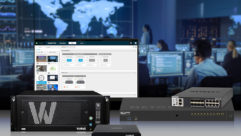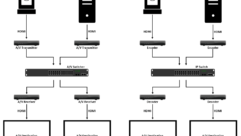
Security Watch:
IP-Based Security
May 1, 2006 12:00 PM,
By Bret Bass
Traditional security panels receive a technology makeover.

As much as the industry enjoys introducing new technologies to the market, it equally dislikes reinventing the wheel. The most successful products are those that improve upon an established mainstay. DVRs, access control systems, and IP alarm transmitters all reflect this. And though information technology and networking considerations now exert a large influence on sales, current industry trends also reveal a return to fundamentals. Since the mad dash to flood the market with DVR products has subsided, installers are rediscovering the benefits of fundamental alarm systems. True to form, though, even burglary panels have received a technological makeover, with Internet-based transmission replacing standard telephone line communication. In fact, Internet Protocol (IP)-based communications seems to have emerged as the spotlight for this year’s ISC West, given the attention that IP alarm products have recently garnered. While knowledge of IP networking is essential to video surveillance installations, it has become equally important for alarm installers who are interested in working with the latest advances in alarm communications.
THE MECHANICS OF IP MONITORING
IP networks generally denote Ethernet, WiFi, or other forms of Internet communications, and they have moved beyond exclusive use in the business sector to more widespread applications in other sectors. Security is one of those sectors. IP alarm panels essentially perform the same tasks as more traditional models, but with greater speed and efficiency, and at lower costs. Another benefit is that IP-based security solutions are scalable; the Internet allows for the transmission of alarm, video, access control, voice, and other communications data, all via existing cables and network connections. For commercial users, the systems integrate directly into their network’s infrastructure. For residential users, the systems tie right into their standard Internet router or modem. If an IP network is currently in place, there is no additional cost to have it carry an alarm system’s data. And for users with multiple facilities, IP-based systems allow for all sites to be remotely administered by a single office, significantly reducing costs.
Many large alarm companies such as Protect America are already launching marketing campaigns geared to sell residential users on IP alarm communicators. There is no additional cost to transmit alarm data over the existing Internet connection, and when the alarm system is no longer communicating over the phone line, monthly telephone costs are also reduced. Though manufacturers are already trying to jump forward with Voice over IP (VoIP) systems, which would eliminate the need for a telephone altogether, having a standard phone line ensures communication redundancy for the IP alarm system. Safeguarding against phone line outages no longer requires radio or cellular backup systems; with IP alarm communicators, if the Internet should fail, the communicators automatically switch over to the phone line.
Most central stations in the industry are already equipped for IP-based monitoring. For central stations, IP alarm systems offer the key benefit of higher security as the devices can be polled by the station every few minutes to ensure uninterrupted functionality. Furthermore, IP alarm transmitters have already been approved for fire and intrusion systems by Underwriters Laboratories (UL Standard 864 and UL Standard 1610, respectively). The only setback to central station monitoring is that each IP transmitter requires a dedicated receiver to communicate. IP transmitters remain proprietary, unlike alarm panels, which may report to any number of central station receivers capable of interpreting standard formats. Before selecting a product line, installers should check with their central stations to ensure that they have the necessary receiving equipment. Table 1 above shows the correlation between the IP transmitter and the central station receiver.

Table 1. For a larger image, click here
INSTALLATION CONSIDERATIONS
For those installers who have hooked up Internet routers either at home or in the field, the installation of the IP alarm transmitter should not present any significant challenges. The first consideration should be the data connection to the network. In terms of cabling, expect to purchase a UTP Cat-5e or higher-quality cable of sufficient length to connect the transmitter (located near or within the alarm control panel) to an available port on the IP network. For commercial sites, this may be an unused RJ45 jack on a wall plate. For a residential installation, this would typically present itself as an open port on the DSL or cable modem. If there are no additional ports, installers may consider purchasing a router or hub before the installation.
PROGRAMMING CONSIDERATIONS
Although IP addressing replaces telephone numbers in programming, the core concept remains unchanged; the system is only concerned with how to call the central station receiver and transmit its data packet. Generally, the installer will need to enter the central station receiver’s IP address, the assigned account number, and in some cases, a central station ID.
Programming methods will differ from product to product, and with receivers. For IP transmitters that are programmable over the network, installers should ensure that they have access to a computer on site, or bring a laptop. Some transmitters, such as the Honeywell 7845i, require a special programming tool. In Honeywell’s specific case, an installer needs a 7720P programmer. Once again, however, installers with previous experience programming panels from manufactures like Honeywell (AlarmNet) and Bosch (Radionics) may already be accustomed to the practice of using programmers. And some transmitters, such as the DSC T-Link, allow for programming using the control panel’s keypad.
COSTS
As with any new product, IP transmitters can be more expensive than traditional alarm communicators. On average, the transmitters tend to cost $250 or more. The additional purchase of a hub or router may cost $50 and up, depending on the brand and model. The cabling itself is generally quite affordable and ranges by cents-per-foot. As with any new venture, integrators must weigh their options against the needs of the customer and the long-term vs. short-term goals. While integrators may incur a heavier upfront cost for IP systems, the return on investment may present itself quickly. Consider the upfront expenditure for a new alarm system and the profit that monitoring generates. Generally, some of the recurring monthly monitoring revenue goes directly to cover phone costs for alarm transmissions. Because there is no associated cost for IP transmissions, integrators have already put more of their RMR into their pockets.
With heightened security features, proactive central station polling of the equipment, reduced telephone expenditures, reduced signal transmission latency of up to 80 percent, and scalability that makes it easier for integrators to introduce other network products (such as remote video), IP-based alarm transmitters give the familiar face of security a much needed makeover.










